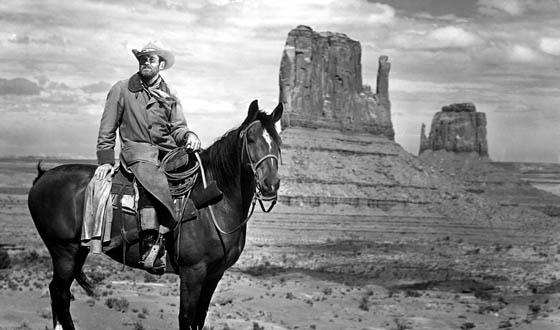 There are perhaps few directors whose films have suffered as much as John Ford’s have in the transition of big screen to televisions. While the politics can be oppressively conservative Ford’s films, without question, always look beautiful. It is this beauty that defines the current series at the MFA running right now, The Making of the Western Myth. Using Monument Valley as an emblem of the west, Ford created a cannon of ten films, all shot in Monument Valley, which came to define the Western.
There are perhaps few directors whose films have suffered as much as John Ford’s have in the transition of big screen to televisions. While the politics can be oppressively conservative Ford’s films, without question, always look beautiful. It is this beauty that defines the current series at the MFA running right now, The Making of the Western Myth. Using Monument Valley as an emblem of the west, Ford created a cannon of ten films, all shot in Monument Valley, which came to define the Western.
What is so fascinating in seeing these films together is that the major themes of Ford’s films become much clearer. Ford often uses the same devices. He consistently portrays the bar the single most important place of social gathering. It is not only a place of death but also birth. It is both grimy and immaculate. Other tropes of Ford include the power of song as a unifying device. Music becomes important not only to credit sequences but to the very plots of his films. Above all of however is the (perhaps overly) sentimental attachment to the land and consequently the history of that land. The love that always exists in Ford’s films is a love of the land.
Each of these films is photographed beautifully. Ford’s aesthetic is, to say the least, unique. To watch a Ford film is to watch a painting come to life. To watch one on “the big screen” is breathtaking. While Monument Valley is beautiful enough to be made pretty by any director, Ford makes it distinctive in each film. More importantly, Ford does not rely on the sheer magnificence of the Valley’s “mittens” as a crutch. My Darling Clementine, and even Stage Coach are films that exist in the West, and for Ford, this is merely what the West looks live – drained of fertility, but with a certain desolate beauty. It is of a certain painful irony that the film that features Monument Valley most prominently in beautiful color, She Wore a Yellow Ribbon, ultimately devalues it.
Monument Valley functions best in Ford’s films when it is part of the story, rather than the story itself as in She Wore a Yellow Ribbon. Ford presents us with the clash of pastoral past and emerging modernity vis a vis Monument Valley in My Darling Clementine leaving the indelible image of Henry Fonda’s Wyatt Earp leaning back in his chair and staring into the desert. In Stagecoach Ford literally brings us through the desert. At the same time he createst a world of its own in the titular vehicle. Other films like Rio Grande play upon the diversity of the grand landscape. One thing for certain is that Ford never used Monument Valley in exactly the same way in two films (though he may have recycled a few of the same shots). Context was always different.
What becomes imminently clear is that few have the stylistic flair that Ford had. He is an auteur in every sense of the word. His Monument Valley films are not only evidence of the creation of the western myth, but they mirror the growth of one of America’s most interesting filmmakers.
-Nicholas Forster